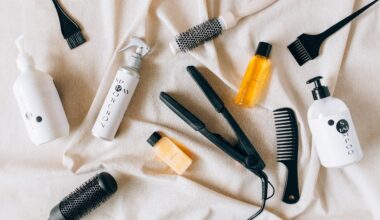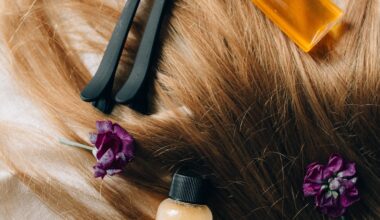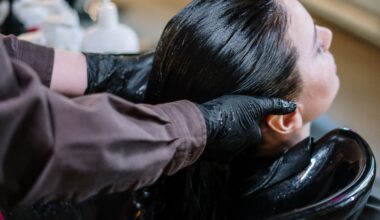Introduction
For decades, women and men alike have sought the secret to sleek, shiny, and straight hair. Enter the Keratin treatment—a game-changer in the world of hair care. With its promises of taming frizzy hair and simplifying daily styling routines, it’s no wonder the treatment has taken the beauty world by storm. But with its increasing popularity arises a wave of concerns, chief among them: can the very treatment designed to enhance our crowning glory cause it to fall out? As someone who’s spent over 20 years taming tresses and addressing clients’ anxieties, I’ve delved deep to unlock the truth behind this burning question.
A few months back, as I was completing a Keratin treatment for one of my regular clients, Sarah, she voiced her concern about some articles she’d come across online. They suggested that this very treatment might lead to hair thinning or loss. Her anxious expression was all too familiar, an echo of concerns I’d heard time and again. If you, like Sarah, are contemplating this transformative treatment but are held back by the fear of hair loss, this article is for you. Together, we’ll explore the intricacies of the Keratin treatment and determine whether there’s any validity to these hair-raising concerns.
Key Takeaways
- Understanding Keratin: A protein naturally present in our hair, Keratin treatments are designed to replenish and restore, giving you smoother, frizz-free locks. But it’s crucial to understand its workings before diving headfirst into the process.
- Separating Fact from Fiction: The internet is brimming with anecdotes about Keratin treatments leading to hair loss. But how many of these stories are rooted in fact? We’ll delve deep into the research to discern myths from reality.
- Possible Causes: While Keratin treatments themselves might not be the direct cause, other factors – such as improper application or aftercare missteps – could be potential culprits behind hair thinning concerns.
- Expert Guidance: No hair treatment should be approached without sound advice. Hear from seasoned professionals about how to safely enjoy the benefits of Keratin treatments while mitigating any potential risks.
- Empowered Choices: With knowledge comes power. By understanding the ins and outs of Keratin treatments, you’ll be better equipped to make informed decisions about your hair care, ensuring your locks remain as luscious as ever.
Understanding Keratin Treatments
If we were to scan the annals of hair care, Keratin would undoubtedly stand out as one of the most influential elements in recent history. But what exactly is Keratin, and how has it revolutionized our hair treatment procedures?
The Essence of Keratin
At its core, Keratin is a protective protein less prone to scratching or tearing than other types of cells our body produces. Naturally present in our hair, skin, and nails, Keratin is the primary protein that gives hair its structure. Over time, due to various external factors like pollutants, chemicals, and heat treatments, the natural Keratin in our hair depletes, leading to dry, damaged, and frizzy locks.
The Promise of Keratin Treatment
Keratin treatments promise to be the knight in shining armor for those battling with unmanageable hair. By applying a mixture laden with Keratin directly onto the hair, this treatment fills the porosity of your hair, as porous hair tends to be frizzy, tangled, and dry. Once the hair absorbs the Keratin, a heating tool (usually a flat iron) is used, sealing it in. The result? Smoother, shinier, and straighter hair that lasts for weeks, even months.
The Deep Dive Into the Treatment’s Mechanism
For the Keratin to work its magic, the hair shaft needs to be meticulously prepared. The process starts with a clarifying shampoo that strips away residue and opens up the hair cuticles. This ensures the Keratin solution penetrates deeply. Once applied, the solution works by rebuilding damaged areas with Keratin. When these proteins bond to the hair, they create a barrier against external elements, thus locking in moisture, UV rays, and pollutants.
Delving Into Concerns: Hair Loss Post Keratin Treatment
In my two decades as a hairstylist, I’ve seen the joy on clients’ faces after a successful Keratin treatment. But, I’ve also sensed the palpable anxiety when they return, clutching bundles of hair and seeking answers. It’s time to address the elephant in the room: Can Keratin treatments lead to hair loss?
Where Do These Concerns Stem From?
There’s no smoke without fire. The concerns about hair loss post-Keratin treatment aren’t unfounded. Some clients have reported increased hair shedding in the days and weeks after undergoing the treatment. A quick online search, and you’ll find a mix of stories – from those who swear by the treatment’s benefits to others who caution against its perils.
Studies and Expert Opinions
Scientific studies and journals don’t directly correlate Keratin treatments with hair loss. But, a few aspects merit attention. Most Keratin treatments involve a chemical called formaldehyde or its derivatives, which helps the solution bond to the hair. When used excessively or improperly, this can weaken the hair shaft. However, it’s also important to note that many brands now offer formaldehyde-free options.
Moreover, hair experts suggest that post-treatment hair shedding might sometimes be mistaken for hair loss. After a Keratin treatment, hair is less prone to breakage, and fewer strands fall out daily. So, when some shedding does occur, it might appear as though more hair is falling out when, in reality, it’s the natural accumulation over days.
Potential Causes of Hair Loss Post-Treatment
- Improper Application: If the treatment is left on for too long or the flat iron’s temperature is set too high, it can weaken the hair shaft, leading to breakage.
- Overuse of Heating Tools: Post-treatment, some might be tempted to frequently straighten their already straight hair, leading to excessive heat damage.
- Lack of Aftercare: Keratin treatments require specific aftercare. Using the wrong products, like sulfates, can strip away the treatment and weaken the hair.
Debunking Myths: The Truth Behind Keratin And Hair Loss
The world of hair care, much like any other, is rife with myths. It’s essential to separate fact from fiction, especially when it comes to a treatment as impactful as Keratin. Here, we will explore and debunk some of the most common myths associated with Keratin treatments and hair loss.
Myth 1: Keratin Treatments Always Lead to Hair Loss
Fact: Simply put, Keratin treatments, when done correctly, do not cause hair loss. Keratin, being a natural protein found in hair, works to replenish hair health. The issue arises when improper techniques, excessive heat, or unsuitable products are used during the procedure.
Myth 2: Any Hair Shedding Post-Treatment Indicates Hair Loss
Fact: Hair shedding is a natural process. On average, a person sheds 50 to 100 hairs a day. Post a Keratin treatment, the reduced daily hair breakage might make it seem like there’s increased shedding when, in fact, it’s just the natural cycle of hair.
Myth 3: Formaldehyde in Keratin Treatments is the Sole Culprit
Fact: While it’s true that some Keratin treatments contain formaldehyde, which can weaken the hair if used incorrectly, many reputable brands have now introduced formaldehyde-free alternatives. The key is to make informed choices and consult with a trusted stylist.
Myth 4: After Keratin Treatment, No More Hair Care is Needed
Fact: Contrary to this belief, aftercare is pivotal! Using the right sulfate-free shampoos, avoiding salt water and chlorine, and minimizing the use of heating tools can ensure the longevity of the treatment and the health of your hair.
Debunking Myths: The Truth Behind Keratin And Hair Loss
The world of hair care, much like any other, is rife with myths. It’s essential to separate fact from fiction, especially when it comes to a treatment as impactful as Keratin. Here, we will explore and debunk some of the most common myths associated with Keratin treatments and hair loss.
Myth 1: Keratin Treatments Always Lead to Hair Loss
Fact: Simply put, Keratin treatments, when done correctly, do not cause hair loss. Keratin, being a natural protein found in hair, works to replenish hair health. The issue arises when improper techniques, excessive heat, or unsuitable products are used during the procedure.
Myth 2: Any Hair Shedding Post-Treatment Indicates Hair Loss
Fact: Hair shedding is a natural process. On average, a person sheds 50 to 100 hairs a day. Post a Keratin treatment, the reduced daily hair breakage might make it seem like there’s increased shedding when, in fact, it’s just the natural cycle of hair.
Myth 3: Formaldehyde in Keratin Treatments is the Sole Culprit
Fact: While it’s true that some Keratin treatments contain formaldehyde, which can weaken the hair if used incorrectly, many reputable brands have now introduced formaldehyde-free alternatives. The key is to make informed choices and consult with a trusted stylist.
Myth 4: After Keratin Treatment, No More Hair Care is Needed
Fact: Contrary to this belief, aftercare is pivotal! Using the right sulfate-free shampoos, avoiding salt water and chlorine, and minimizing the use of heating tools can ensure the longevity of the treatment and the health of your hair.
Empowered Choices: Recognizing and Mitigating Potential Risks
Empowerment in beauty and self-care stems from being informed and taking proactive measures. As you journey through the realm of Keratin treatments, it’s imperative to be aware of potential pitfalls and to arm oneself with the knowledge to sidestep them.
Be Skeptical of Overly Cheap Deals
While everyone loves a good bargain, it’s essential to approach extremely discounted Keratin treatments with caution. Often, low prices may hint at the use of sub-par products or inexperienced technicians. Remember, with hair treatments, sometimes you truly get what you pay for.
Do a Patch Test
If you’re trying out a new salon or product, always ask for a patch test. This simple procedure can alert you to potential allergic reactions or sensitivities. It’s a small step that can prevent larger complications down the line.
Listen to Your Hair
Your hair has its unique way of communicating its health to you. If you notice excessive dryness, brittleness, or breakage after a Keratin treatment, it may be signaling that something went amiss during the procedure. In such cases, consult with a trusted hair care expert.
Stay Updated
The world of hair care is continually evolving, with new products, techniques, and studies emerging. Regularly updating oneself can ensure that you are always making the best choices for your hair health.
Open Dialogue with Your Stylist
Maintain an open line of communication with your hairstylist. If you have concerns or questions post-treatment, don’t hesitate to reach out. A professional stylist will provide guidance and solutions.
Conclusion
Keratin treatments, when done right, can be transformative. They offer a promise of smoother, frizz-free, and manageable hair. However, like any treatment, it’s crucial to approach it with awareness and knowledge. By recognizing potential concerns, debunking myths, and making empowered choices, you can ensure the health and beauty of your locks.
I hope this article provides clarity on the topic of Keratin treatments and hair loss, offering a balanced perspective backed by expertise. If you have any feedback or require further adjustments, please let me know!






